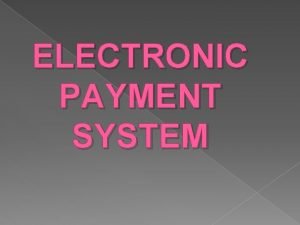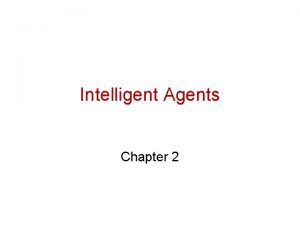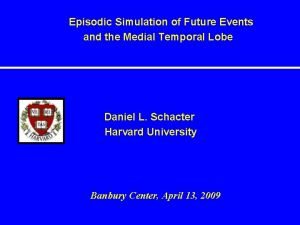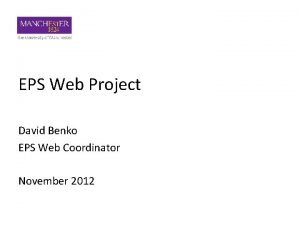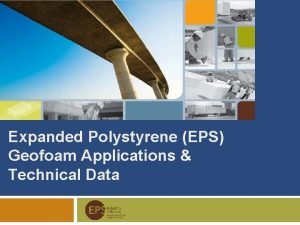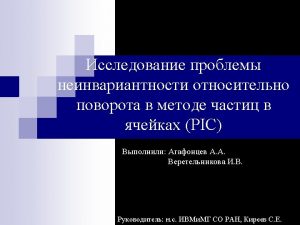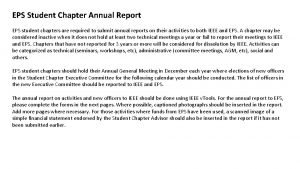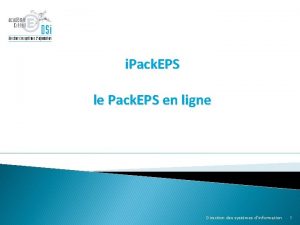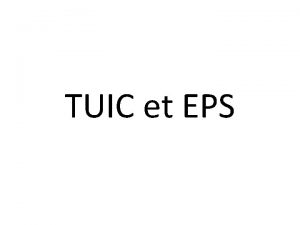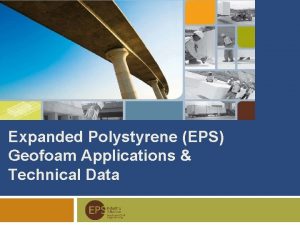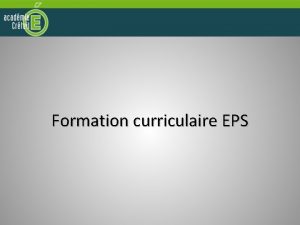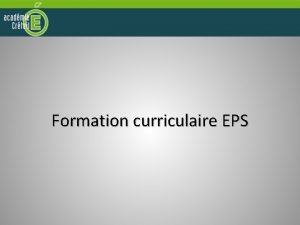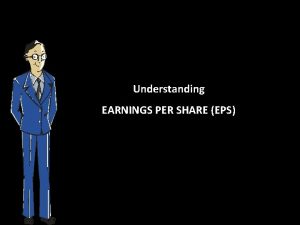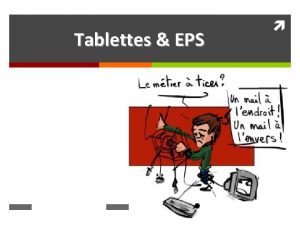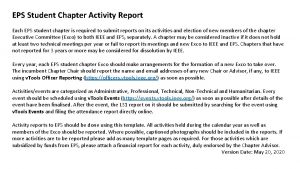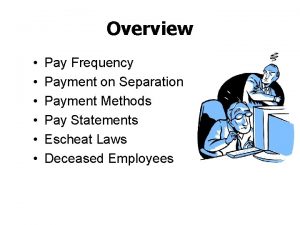Overview of Episodic Payment System EPS for Certified






















































- Slides: 54

Overview of Episodic Payment System (EPS) for Certified Home Health Agencies Effective May 1, 2012 (Revised April 17, 2013) 1

Episodic Payment System (EPS) Continues Medicaid Redesign Team (MRT) Efforts to Reduce and Control Utilization From 2003 to 2009: ◦ Medicaid Costs for CHHAs increased 77. 4% ◦ Cost per patient increased 89. 5% ◦ The number of patients receiving CHHA services declined by 6. 4% MRT Initiative #5 ◦ Phase 1: Effective April 1, 2011 implemented aggregate annual per patient spending limits ◦ Phase 2: Effective May 1, 2012, Episodic Payment System Implemented ◦ Phase 3: Effective 2012/2013, begin roll-out of mandatory enrollment of certain individuals who require community-based long-term care - will include phase-in of dual eligible CHHA patients 2

NYS Episodic Payment System (EPS) EPS took effect on May 1, 2012 NYS EPS is similar to Medicare EPS, but there are significant differences Applies to all CHHA patients except: ◦ Patients under 18 years of age ◦ Participants in a pilot program approved by the Department of Health to provide services to medically complex and fragile children, adolescents and young disabled adults ◦ Traditional fee-for-service billing will continue for both of these patient groups A Statewide Base Price for 60 -day episodes of care is adjusted for patient acuity using a NYS Medicaid grouper, regional wage differences, and if applicable, outlier payments. 3

NYS Episodic Payment System (EPS) COMPONENT ONE Base Price Per Episode (Full Episode = 60 days) COMPONENT TWO Patient CMI Determined by NYS Medicaid Grouper COMPONENT FOUR Outlier Payment (if applicable) COMPONENT THREE Regional Wage Index Factor Total Episodic Payment 4

Component One of EPS System: Base Price 5

Component One of EPS: Base Price Payments are based on 60 -day episodes of care Statewide Base Price for all episodes = $5, 633 effective May 1, 2012 o Low Utilization Payment Amount (LUPA) may be applicable Statewide base price adjusted for: o Case mix (patient acuity) using OASIS data and NYS Medicaid Grouper o Regional wage differences ~ Wage Index Factor o Outlier Payments (if applicable) 6

Component Two of EPS System: Case Mix Adjustment Using NYS Medicaid Grouper 7

NYS Medicaid CHHA Grouper Per statute, Medicaid Grouper developed using 2009 claims data and OASIS-B assessment information The 2009 Medicaid Grouper is compatible with the OASIS-C assessment data now in effect will be run through the Medicaid CHHA Grouper to determine the case mix component of EPS system 8

Overview of NYS Medicaid Grouper (Used to Determine Case Mix Adjustment) NYS Medicaid Grouper Clinical Medicaid Clinical Measures – 3 Groups (A, B, C) Functional Medicaid Functional Measures – 3 Groups (E, F, G) Assessment Reason 2 Groups – Start of Care or Recertification (0 , 1) Age 6 Age Groups (1 -6) Total # Case Mix Groups/Weights Total: 108 Case Mix Groups (3*3*2*6) 9

OASIS-C Clinical and Functional Factors Included in NYS Medicaid CHHA Grouper 7 Clinical Factors 1) Diabetes diagnoses 2) Orthopedic diagnoses 3) Dementia diagnoses 4) HIV diagnoses 5) Bowel Incontinence 6) Urinary Incontinence 7) Shortness of Breath 3 Clinical Groups: A=0 -4 points B=5 -14 points C=15+ points 4 Functional Factors 1) ADL Dressing upper body 2) ADL Dressing lower body 3) ADL Toileting 4) ADL Transferring 3 Functional Groups: E=0 -18 points F=19 -51 points G=52+ points 10

OASIS-C Age and Assessment Factors Included in NYS Medicaid CHHA Grouper Assessment Reason (2 Groups) 0) Start of Care (M 0100 = 1 or 3) 1) Recertification of Care (M 0100 = 4 or 5) Age (6 Groups) 1) Less than 60 2) 60 -69 3) 70 -74 4) 75 -79 5) 80 -84 6) 85+ 11

NYS Medicaid CHHA Grouper (Point Scale to Determine Clinical and Functional Groups) Response Level Item Item Number OASIS-C 0 1 2 3 4 Dx of Diabetes M 1020/M 1022 0 4 Dx of Orthopedic M 1020/M 1022 0 2 Dx of Dementia M 1020/M 1022 0 24 Dx of HIV M 1020/M 1022 0 10 Bowel Incontinence M 1620 0 Urinary Incontinence M 1610 0 6 0 Shortness of Breath M 1400 0 4 4 4 Dress Upper M 1810 0 8 18 18 Dress Lower M 1820 0 0 12 21 Toilet M 1840 0 13 20 20 20 Transfer M 1850 0 0 9 9 15 5 5 4 15 12

Example Case Mix ~ Mrs. Smith Assessment Reason: Recertification =1 Age Group 70 -74 (Age = 3) Point s Diabetes 4 Orthopedic Condition (Arthritis) 2 Dementia diagnosis 0 HIV diagnosis 0 Bowel Incontinence less than Once Weekly Response 1 0 Urinary Incontinence Response 1 6 No Shortness of Breath 0 Clinical Score (A= 0 -4, B=5 -14, C=15+) 12 = B 13

Mrs. Smith Assessment Reason: Recertification =1 Age Group 70 -74 (Age = 3) Points Dress Upper Body Response 1 (needs clothes laid out) 8 Dress Lower Body Response 1 (needs clothes laid out) 0 Toileting Response 1 (needs to be reminded, supervised, assisted) 13 Transferring Response 1 0 Functional Score (E=0 -18, F= 19 -51, G=52+) 21=F Mrs. Smith: Case Mix Group = 1 B F 3 14

108 Case Mix Groups Are Assigned Individual Rate Codes Each of the 108 Case Mix Groups is tied to a Rate Code The following table provides 6 examples of the 108 Rate Codes. Assessment Reason* Clinical Group Functional Group Age Group Case Mix Rate Code 0 A E 1 . 243422 4810 0 B F 2 . 691567 4835 0 C G 3 1. 963598 4860 1 A E 4 . 515132 4867 1 B F 3 . 934108 4890 C G 6 2. 480934 4917 (Mrs. Smith Ex. ) 1 * Assessment Reason 0: Start of Care 1: Recertification 15

Developing a Grouper Module Providers/vendors need to create their own module which will generate one of the 108 grouper-based rate codes to be used in billing. ◦ Two additional rate codes will be used for special situations (see “Billing Procedures” section). NYSDOH also has made SAS code available to providers. 16

Latest Available OASIS will be Used to Transition Patients to EPS To transition patients eligible for Medicaid fee-for-service coverage, providers will begin an initial episode effective May 1, 2012 or later using the latest OASIS assessment available (within the last 65 days) for that patient. Providers will have the option of using a partial Medicaid episode (less than 60 days) to synchronize episodes with Medicare and with the existing assessment cycle. If claim reflects a partial episode, a pro-rated payment will be based on the Dates of Service as claimed on UB-04, field 6: “Statement Covers Period From/Through” (see “Billing Procedures” section for exceptions). 17

OASIS Transition Example Medicare Episode: April 15 – June 13 Medicaid Episodic System Begins May 1 If provider chooses to synchronize Medicaid and Medicare episodes: ◦ ◦ ◦ Initial Medicaid Claim: May 1 – June 13 Use OASIS data collected no more than 65 days prior to May 1 Results in partial episodic payment for Medicaid Subsequent Medicaid Claim: June 14 – August 12 Is now synchronized with Medicare episode OR: CHHA may claim a full Medicaid episode, May 1 – June 29 18

Component Three of EPS System: Regional Wage Index Factor 19

Calculation of Wage Index Factors The WIFs are calculated for 10 Labor Market Regions defined by the NYS Department of Labor Average wages are extracted from the Occupational Employment Statistics compiled by the Federal Bureau of Labor Statistics for five occupational categories: ◦ Home Health Aides, Registered Nurses, Occupational Therapists, Physical Therapists, Speech Therapists Occupational categories are weighted according to each Region’s Medicaid utilization as reported in the CHHA certified cost reports Wage Index Factors are adjusted proportionately to ensure that the application of the factors will be revenue neutral The Wage Index Factor is applied to 77% of the total reimbursement amount ◦ Percentage is approximately equal to the percentage used in Medicare PPS to measure the average portion of agency costs which are labor-related 20

Wage Index Factors Effective May 1, 2012 Region Wage Index Counties Capital . 911944 Albany, Columbia, Greene, Rensselaer, Saratoga, Schenectady, Warren, Washington Central New York 1. 002872 Cayuga, Cortland, Madison, Onondaga, Oswego Finger Lakes 1. 093141 Genesee, Livingston, Monroe, Ontario, Orleans, Seneca, Wayne, Wyoming, Yates Hudson Valley 1. 125693 Dutchess, Orange, Putnam, Rockland, Sullivan, Ulster, Westchester Long Island 1. 078872 Nassau, Suffolk Mohawk Valley . 955006 Fulton, Herkimer, Montgomery, Oneida, Otsego, Schoharie New York City . 991433 Bronx, Kings, Queens, New York, Richmond North Country . 955610 Clinton, Essex, Franklin, Hamilton, Jefferson, Lewis, St. Lawrence Southern Tier . 866871 Broome, Chemung, Chenango, Delaware, Schuyler, Steuben, Tioga, Tompkins Western New York . 903208 Allegany, Cattaraugus, Chautauqua, Erie, Niagara 21

Example of Wage Index Factor Calculation: Capital Region Registered Nurses Physical Therapy Speech Therapy Occupational Home Therapy Health Aides Regional Average Wage $29. 75 $32. 46 $30. 57 $31. 17 $12. 48 Statewide Average Wage $36. 08 $37. 62 $37. 42 $33. 99 $11. 37 Ratio (Region/Statewide) . 8244 . 8627 . 8169 . 9171 1. 0973 Weighting * . 6298 . 1386 . 0287 . 0488 . 1541 WIF - Total weighted ratio**. 876061 WIF - Adjusted for revenue neutrality. 911944 * Weighting is based on Medicaid visits reported in certified cost reports by CHHAs in Capital Region: Nursing: 30, 417 (. 6298) PT: 6, 695 (. 1386) Speech: 1, 387 (. 0287) OT: 2, 356 (. 0488) HHA: 7, 443 (. 1541) ** (. 8244 X. 6298) + (. 8627 x. 1386) + (. 8169 x. 0287) + (. 9171 x. 0488) + (1. 0973 x. 1541) =. 876061 22

Application of Wage Index Factors To calculate reimbursement amounts, the Wage Index Factor (applicable to 77% of total) is converted to a “Single Adjustment Factor” (SAF) which is applied to 100% of the claim. SAFs used by the payment system are as follows: “Wage Index Factor” effective 5/1/12 “Single Adjustment Factor” effective 5/1/12 Capital . 911944 . 93220 Central New York 1. 002872 1. 00221 Finger Lakes 1. 093141 1. 07172 Hudson Valley 1. 125693 1. 09678 Long Island 1. 078872 1. 06073 Mohawk Valley . 955006 . 96535 New York City . 991433 . 99340 North Country . 955610 . 96582 Southern Tier . 866871 . 89749 Western New York . 903208 . 92547 Region 23

Example: Mrs. Smith (1 BF 3) Recertification Assessment, New York City CHHA, Clinical B, Functional F, Age Group 3: 70 -74 Base Price $5, 633 Case Mix. 934108 NYC SAF . 99340 Total Episodic Price $5, 227. 10 24

Component Four of EPS System: Outlier Payments (If Applicable) 25

Outlier Payments and Thresholds Outlier Payments (made in addition to the case mix and WIF adjusted base price) are applicable to costs which exceed an outlier threshold A separate and unique threshold is established for each of the 108 case mix groups The outlier threshold increases with patient need/severity of condition Higher clinical – higher threshold Higher functional – higher threshold Older age – higher threshold Outlier payments are equal to 50% of the costs that exceed the outlier threshold 26

Examples of Outlier Threshold Percentiles Assessment Reason Clinical Group Functional Group Age Group Outlier Threshold Start of Care = 0 A E 70 -74 =3 $3, 660 Start of Care = 0 A G $17, 619 Start of Care = 0 B F 85+ = 6 Under 60 = 1 Start of Care = 0 C E 75 -79 = 4 $8, 821 Start of Care = 0 C G 80 -84 = 5 $26, 679 Recertification =1 A F 60 -69 = 2 $8, 670 Recertification =1 B E 80 -84 =5 $6, 318 Recertification = 1 (Mrs. Smith Ex) B F 70 -74 = 3 $9, 720 Recertification = 1 C E 75 -79 = 4 $10, 269 Recertification = 1 C G 85+ = 6 $28, 600 $6, 991 27

Determining Costs and Calculating Outlier Payments The EPS will use the latest fee-for-service rates in effect as of May 1, 2012 to calculate statewide weighted average rates for specific CHHA services to determine the “Service Cost” of each episode of care The average rates will be tied to Revenue Codes The provider will report units of service (hours, visits, etc) provided on each date during each episode The e. Med. NY system will multiply the units of service times the statewide rates associated with the appropriate Revenue Codes to compute the service cost of the episode If the costs exceed the outlier threshold for the case mix group, the CHHA will receive the Base Price adjusted by Case Mix and WIF plus 50% of the costs that exceed the outlier threshold ◦ The outlier payment also will be adjusted by the WIF 28

Revenue Codes for EPS Service Unit Statewide Revenue Weighted Code Average Rate Skilled Nursing Visit $102. 15 0551 Physical Therapy Visit $113. 89 0421 Speech/Language Pathology/Therapy Visit $112. 83 0441 Occupational Therapy Visit $108. 67 0431 Home Health Aide Hour $17. 92 0572 Shared Aide Qtr. Hour $4. 48 0579 AIDS Skilled Nursing Visit $102. 15 0559 Telehealth I, III Day $9. 52 0780 Telehealth Installation One-Time $50. 00 0590 $77. 88 0581 MOMS Health Supportive Visit Services 29

Example: Outlier Payment for Mrs. Smith Recertification Assessment, New York City CHHA, Clinical B, Functional F, Age Group 70 -74 Base Price $5, 633 Case Mix . 934108 NYC SAF . 99340 (based on NYC WIF of . 991433) Outlier Payment $1, 132. 48 Total Episodic Payment $6, 359. 58 Mrs. Smith Total cost of visits/hours (Statewide rates for each revenue code, multiplied by units of service) Outlier Threshold Costs in Excess of Outlier Threshold $12, 000 $9, 720 $2, 280 Outlier Payment (50% of Excess, with 77% Adjusted by WIF) $1, 140*. 99340 (SAF) = $1, 132. 48 30

LUPAs, Length of Stay (Partial/Full), and Interim Payments 31

Low Utilization Payment Amounts (LUPAs) If “service cost” of episode is $500 or less, the CHHA receives a Low Utilization Payment Amount (LUPA) The service cost of the episode is computed by multiplying the units of service times the statewide weighted average rates associated with the appropriate Revenue Codes The LUPA is equal to the computed cost ◦ The payment is adjusted by the applicable Single Adjustment Factor (based on the Wage Index Factor) NOTE: $500. 00 threshold is applied BEFORE wage adjustment – Wage-adjusted LUPA payment can be more than $500. 00 even if unadjusted charges (based on Revenue Codes) are <= $500. 00 32

Partial and Full Episodic Payments ~ Payments for Patients Discharged in Less Than 60 Days To maintain billing integrity and to properly implement the EPS while certain CHHA patients are enrolled in MLTCPs/CCMs, episodes of less than 60 days will result in partial payments if the CHHA patient is discharged to another Long Term Care setting, including MLTC/CCM, LTHHCP, Nursing Home Partial episodic payments also will apply to patients who are discharged to another CHHA Full episodic payments will be made for CHHA patients who are discharged in less than 60 days only if discharged to: ◦ The Community/Home ◦ Hospital ◦ Hospice ◦ Or in cases of death (See examples in the “Billing Procedures” section of this presentation) 33

Interim Payments To assist providers with cash flow during an episode, providers may submit a claim early in the episode for an Interim Payments are equal to 50% of the episodic base price, based on the reported Rate Code, adjusted for CMI and Wage Index ◦ Interim claims must include at least one date of service showing the applicable Revenue Code When the final claim for the same episode is submitted, the full final payment is calculated ◦ The full final payment is processed as an adjustment or “takeback” of the Interim Claim and full payment of the final claim 34

Examples: Calculating Reimbursement Under the EPS 35

Episodic Payment System: Reimbursement Examples The following pages provide 6 examples of how payments to providers will be calculated: 1. Interim Payment 2. Full episode - no LUPA, no outlier reimbursement 3. Full episode - with outlier reimbursement 4. Full episode – LUPA 5. Partial episode - no LUPA, no outlier reimbursement 6. Partial episode – with outlier reimbursement 36

Episodic Payment System: Reimbursement Examples The following information will apply to all 6 payment examples: • Patient is served by a CHHA in New York City • Reason for OASIS assessment is Recertification (1) • Clinical group is B • Functional Group is F • Patient is 72 years old (Age Group 3) • Statewide Base Price is $5, 633 • Case Mix Index for Resource Group 1 -B-F-3 = 0. 934108 • Outlier Threshold for 1 -B-F-3 = $9, 720 • Wage Index Factor applied to 77% of reimbursement; Single Adjustment Factor (SAF) applied to 100% of reimbursement 37

Example #1: Interim Payment (1 BF 3) Base Price $5, 633 NYC SAF (. 99340) applied to 100% of payment – based on NYC Wage Index Factor of. 991433 Statewide Case Mix Adjusted Price $5, 261. 83 Case Mix. 934108 Total Price Adjusted for Case Mix and Wage Index $5, 227. 10 . 5 (50% of Price Adj. for Case Mix and Wage Index) $2, 613. 55 38

Example #2: Full Episode – No LUPA, No Outlier Adjustment (1 BF 3) Base Price $5, 633 Statewide Case Mix Adjusted Price $5, 261. 83 Case Mix. 934108 NYC SAF (. 99340) applied to 100% of payment – based on NYC Wage Index Factor of. 991433 Statewide Case Mix Adjusted Price $5, 261. 83 Total Price Adjusted for Case Mix and Wage Index $5, 227. 10 (If Interim Payment was received, provider will receive Final Payment of $5, 227. 10 minus “takeback” of Interim Payment - e. g. $2, 613. 55 in Example #1). 39

Example #3: Full Episode with Outlier Reimbursement Total charges for visits, hours, etc. reported by CHHA based on Revenue Codes = $12, 000 Outlier Threshold for this Resource Group = $9, 720 Charges in excess of outlier threshold = $2, 280 Provider will receive outlier payment of $2, 280 X 50% = $1, 140 This amount will be adjusted by SAF (based on Wage Index Factor) Net outlier payment (NYC Provider) = $1, 132. 48 Base Price adjusted for WIF and Case Mix (from Example #1): $5, 227. 10 Outlier Payment, adjusted for WIF: $1, 132. 48 Total Episodic Payment: $6, 359. 58 (Interim Payment, if any, will be reversed when Final Payment is made) 40

Example #4: Full Episode – Low Utilization (LUPA) (1 BF 3) Total charges for visits, hours, etc. reported by CHHA based on Revenue Codes = $450. 00 As this is less than (or equal to) $500. 00, Low Utilization Payment will apply – REGARDLESS of length of episode Provider will receive actual charges produced by Revenue Codes: This amount will be adjusted by the SAF (based on Wage Index Factor) Net payment (NYC Provider) = $447. 03 (Interim Payment, if any, will be reversed when Final Payment is made) 41

Example #5: Partial Episode – No LUPA, No Outlier Adjustment (1 BF 3) “From” Date on Claim Form: “Through” Date on Claim Form: Length of Episode: Episodic Price Adjusted for Wage Index Factor and Case Mix (from Example #1): $5, 227. 10 40 / 60 May 15, 2012 June 23, 2012 40 Days Total Reimbursement for Partial Episode: $3, 484. 73 (Interim Payment, if any, will be reversed when Final Payment is made) 42

Example #6: Partial Episode with Outlier Reimbursement (1 BF 3) “From” Date on Claim Form: “Through” Date on Claim Form: Length of Episode: May 15, 2012 June 23, 2012 40 Days Total charges for visits, hours, etc. reported by CHHA based on Revenue Codes = $12, 000 Charges in excess of outlier threshold = $2, 280 Full Episodic Price Adjusted for WIF and Case Mix (from Example #1): $5, 227. 10 Outlier Payment adjusted for WIF (from Example #3): $1, 132. 48 Total Payment Before Adjustment for Partial Period: 40 / 60 Total Payment for Partial Episode: $4, 239. 72 $6, 359. 58 (Interim Payment, if any, will be reversed when Final Payment is made) 43

Billing Procedures 44

General Information The Episodic Payment System took effect on May 1, 2012 and applies to CHHA Medicaid services provided on and after that date ◦ Exceptions apply to services provided to patients under age 18 and specified pilot programs OASIS assessments will continue to be completed in accordance with Federal requirements and will be used by the NYS Medicaid Grouper to determine case mix Medicaid continues to be the “payer of last resort” - services which are covered by Medicare or other payers should not be included on Medicaid claim forms 45

New Procedures for Completing Medicaid Claims The third digit of “Type of Bill” (UB-04 field #4) must be shown as: ◦ “ 2” for Interim Claim ◦ “ 9” for Final Claim (full or partial) or Adjusted Claim The Occurrence Code 50 (fields 31 -36) should be used to report Date of Assessment (OASIS) – required field for Rate Codes 4810 through 4917 Rate Code (fields 39 -41) must be one of the new 110 episodic Rate Codes ◦ Rate Codes should be based on patient’s age as of the “Through” date on the claim Revenue Code (field 42) and Service Units (field 46) must be shown for each Service Date (field 45). Procedure Code (field 44) must continue to be completed 46

New Procedures for Completing Medicaid Claims The Length of episode will be determined by “Statement Covers Period From/Through” dates (UB-04 field #6) The “From and Through” dates on the claim represent the beginning and end of an episode ◦ If the Episode is First Medicaid Episode: From Date: Date of the first billable Medicaid service (a Medicaid Start of Care episode cannot begin until a billable service is provided) Through Date: End of 60 -day period or the last date services provided if partial episode ◦ If the Episode is a Subsequent Episode (continuous care is provided to patient): From Date: the date immediately following the through date for the previous episode Through Date: End of the 60 -day period or the last date of services provided if partial episode 47

New Procedures for Completing Medicaid Claims Interim Claims: ◦ Must include at least one date of service showing the applicable Revenue Code ◦ When the final claim for the same episode is submitted, the full final payment is calculated The full final payment is processed as an adjustment or “takeback” of the Interim Claim and payment of the final claim This will be reflected on the remittance in the same way an adjusted claim is shown now under fee-for-service billing ◦ The TCN on the Final Claim must match the TCN on the Interim Claim ◦ Interim Claims will be voided after 150 days if no corresponding final claim is received 48

New Procedures for Completing Medicaid Claims All service units billable to Medicaid should be listed on the final claim Any applicable surplus/spend-down amount should be offset on the claim in fields 39 -41 of the UB-04 ◦ It will be the provider’s responsibility to report all surplus/spenddown amounts during the appropriate time period Claims must be submitted within 90 days after the end of the episode 49

Partial Episodes that Qualify for Full 60 -Day Payment Ø Reimbursement will be pro-rated for partial episodes (difference between From and Through dates is less than 60 days). Ø EXCEPTIONS: Ø CHHAs will receive full 60 -day reimbursement amount if a partial episodic claim indicates one of the following Discharge Status Codes (field 17 on UB-04): 01 – Discharged to Home or Self-Care 02 – Discharged/Transferred to Hospital 20 – Patient Expired 50 – Discharged to Hospice (Home) 51 – Discharged to Hospice (Medical Facility) Ø If the CHHA later resumes care for the patient within 60 days of the original “From” date, the agency must file a corrected claim to prevent double billing. 50

Episodic Rate Codes 108 rate codes are based on NYS Medicaid Grouper methodology (rate codes 4810 through 4917). Rate code 4919: Assessments only – no other services in 60 -day period – should be used only for LUPA claims. Rate code 4920: Maternity only – maternity patients 18 and older, no OASIS available – Case Mix Index and Outlier Threshold are the same as rate code 4810 (lowest acuity group). Occurrence Code 50 (used to report OASIS assessment date) is not required for rate codes 4919 and 4920. 51

Future Updates to EPS Methodology As required by statute, the elements of the EPS (Base price, Medicaid Grouper, outlier payments, etc. ) were developed using 2009 claims data and OASIS-B assessment information which do not reflect the transition of CHHA patients to MLTCPs/CCMs When sufficient data is available from the 2012 -13 claims, the Department will re-evaluate the elements of the EPS, including: ◦ The Base Year ◦ The Base Price ◦ The Medicaid Grouper ◦ Partial Episodic Payments 52

Resources Detailed information about the Episodic Payment System is available at the following DOH website: http: //www. health. ny. gov/facilities/long_term_care/reimbursement/chha/ This information includes: Base price, resource groups, case mix indices, rate codes Outlier thresholds Weighted average rates for LUPAs and outliers Regional wage index factors Billing guidelines Medicaid grouper details Episodic Payment System Q&A 53

Resources Billing updates have been posted to the DOH website regarding the following subjects: Acceptable assessment dates Requirements for written medical orders Maximum number of service units per day Proper reporting of spend down and surplus Future updates will be posted on the same site. Questions regarding the Episodic Payment System should be submitted to the following email address: bltcr-ch@health. state. ny. us 54
 Electronic payment system definition
Electronic payment system definition Semantic memory
Semantic memory Climactic structure examples
Climactic structure examples Interactive english tutor peas
Interactive english tutor peas Thematic vs episodic framing
Thematic vs episodic framing Constructive episodic simulation hypothesis
Constructive episodic simulation hypothesis Episodic structure definition
Episodic structure definition Incose certification
Incose certification Twic nexgen
Twic nexgen Kontinuitetshantering i praktiken
Kontinuitetshantering i praktiken Novell typiska drag
Novell typiska drag Tack för att ni lyssnade bild
Tack för att ni lyssnade bild Returpilarna
Returpilarna Shingelfrisyren
Shingelfrisyren En lathund för arbete med kontinuitetshantering
En lathund för arbete med kontinuitetshantering Adressändring ideell förening
Adressändring ideell förening Tidbok för yrkesförare
Tidbok för yrkesförare A gastrica
A gastrica Vad är densitet
Vad är densitet Datorkunskap för nybörjare
Datorkunskap för nybörjare Stig kerman
Stig kerman Tes debattartikel
Tes debattartikel Delegerande ledarskap
Delegerande ledarskap Nyckelkompetenser för livslångt lärande
Nyckelkompetenser för livslångt lärande Påbyggnader för flakfordon
Påbyggnader för flakfordon Formel för lufttryck
Formel för lufttryck Publik sektor
Publik sektor Urban torhamn
Urban torhamn Presentera för publik crossboss
Presentera för publik crossboss Argument för teckenspråk som minoritetsspråk
Argument för teckenspråk som minoritetsspråk Kanaans land
Kanaans land Treserva lathund
Treserva lathund Luftstrupen för medicinare
Luftstrupen för medicinare Bästa kameran för astrofoto
Bästa kameran för astrofoto Cks
Cks Byggprocessen steg för steg
Byggprocessen steg för steg Bra mat för unga idrottare
Bra mat för unga idrottare Verktyg för automatisering av utbetalningar
Verktyg för automatisering av utbetalningar Rutin för avvikelsehantering
Rutin för avvikelsehantering Smärtskolan kunskap för livet
Smärtskolan kunskap för livet Ministerstyre för och nackdelar
Ministerstyre för och nackdelar Tack för att ni har lyssnat
Tack för att ni har lyssnat Referat mall
Referat mall Redogör för vad psykologi är
Redogör för vad psykologi är Matematisk modellering eksempel
Matematisk modellering eksempel Atmosfr
Atmosfr Borra hål för knoppar
Borra hål för knoppar Orubbliga rättigheter
Orubbliga rättigheter Formula varians
Formula varians Tack för att ni har lyssnat
Tack för att ni har lyssnat Rita perspektiv
Rita perspektiv Verksamhetsanalys exempel
Verksamhetsanalys exempel Tobinskatten för och nackdelar
Tobinskatten för och nackdelar Blomman för dagen drog
Blomman för dagen drog Handledning reflektionsmodellen
Handledning reflektionsmodellen
